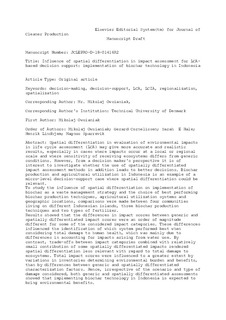Influence of spatial differentiation in impact assessment for LCA-based decision support: implementation of biochar technology in Indonesia
Journal article, Peer reviewed
Accepted version
Permanent lenke
http://hdl.handle.net/11250/2560651Utgivelsesdato
2018Metadata
Vis full innførselSamlinger
- NGI articles [1037]
Originalversjon
Journal of Cleaner Production. 2018, 200 259-268. https://doi.org/10.1016/jclpro.2018.07.256Sammendrag
Spatial differentiation in evaluation of environmental impacts
in life cycle assessment (LCA) may give more accurate and realistic
results, especially in cases where impacts occur at a local or regional
scale and where sensitivity of receiving ecosystems differs from generic
conditions. However, from a decision maker's perspective it is of
interest to investigate whether the use of spatially differentiated
impact assessment methods in addition leads to better decisions. Biochar
production and agricultural utilization in Indonesia is an example of a
micro-level decision-support case where spatial differentiation could be
relevant.
To study the influence of spatial differentiation on implementation of
biochar as a waste management strategy and the choice of best performing
biochar production techniques, agricultural utilization systems and
geographic locations, comparisons were made between four communities
living on different Indonesian islands, three biochar production
techniques and two types of fertilizer.
Results showed that the differences in impact scores between generic and
spatially differentiated impact scores were an order of magnitude
different for some of the considered impact categories. These differences
influenced the identification of which system performed best when
considering total damage to human health, which was mainly due to
differences in accounting for impacts arising from water use. By
contrast, trade-offs between impact categories combined with relatively
small contribution of some spatially differentiated impacts rendered
spatial differentiation less relevant with regard to total damage to
ecosystems. Total impact scores were influenced to a greater extent by
variations in inventories determining environmental burden and benefits,
than by differences between generic and spatially differentiated
characterization factors. Hence, irrespective of the scenario and type of
damage considered, both generic and spatially differentiated assessments
showed that implementing biochar technology in Indonesia is expected to
bring environmental benefits.
It was shown that spatial differentiation in impact assessment did not
necessary lead to better decisions in this case study. This may suggest
that depending on the goal of the LCA, practitioners should consider
potential benefits of implementing spatially differentiated life cycle
impact assessment methods as opposed to potential benefits from
collecting site-specific inventories.
